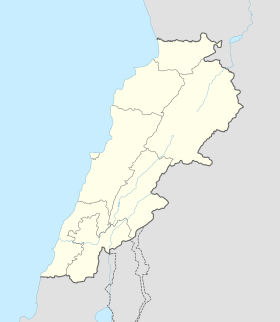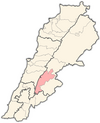Joub Jannine
Joub Jannine, Lebanon | |
 Joub Jannine in 2016 | |
| Alternative name | Jeb Jannine |
|---|---|
| Location | Beqaa Valley, Lebanon |
| Coordinates | 33°38′N 35°47′E / 33.63°N 35.78°E |
| Part of | Beqaa District |
| History | |
| Periods | Trihedral Neolithic, Heavy Neolithic, Neolithic |
| Site notes | |
| Archaeologists | Henri Fleisch |
| Condition | ruins |
| Public access | Yes |
Joub Jannine is the capital of West Beqaa. It is a town and the center of the
Joub Jannine is surrounded by a number of villages. To the south there is the village of Lala, Ghazze to the north,
History
In 1838,
Archaeological sites
Joub Jannine I is a small surface site brought to the surface through erosional activity of a stream. It is 8 km northeast of Qaraoun in a range of foothills, 1 km north of a small village called
Joub Jannine II was first discovered by M. Billaux in 1957. It was described by
The material from Joub Jannine II was described by Lorraine Copeland as
Unique in Lebanon, except for isolated pieces at other sites, and consists of core-tools evidently made for a special purpose. (see Trihedral lithic pictured)[3]
Joub Jannine III (The Gardens) is a
Tourism & Nightlife
Tourism
Joub Jannine is not really known for tourism. However, it is home to one of the oldest bridges in Lebanon, called The Roman Bridge of Joub Jannine (built in 704 AD). The bridge collapsed in 1943, but it was rebuilt with the same rocks and is currently identical to the bridge the Romans built. It is located at the entrance of Joub Jannine on Joub Jannine-Chtoura Rd.

Nightlife

Joub Jannine is known for its variety in restaurants and cafes which make it a destination town for most surrounding villages. All restaurants and fast food joints serve Argileh (Shisha).
Nightlife exists but limited due to the towns size and distance from the major cities. Nightlife is limited to some operating cafeterias, bars and restaurants around the town which serve alcoholic drinks and quick bite plates and stay open a little past midnight.
References
- ISBN 978-1-904777-85-4. Retrieved 30 April 2011.
- ^ Robinson and Smith, 1841, vol 3, 2nd appendix, p. 142
- ^ a b L. Copeland; P. Wescombe (1966). Inventory of Stone-Age Sites in Lebanon: North, South and East-Central Lebanon, p. 34-35. Impr. Catholique. Retrieved 29 August 2011.
- ^ ISBN 978-0-87074-146-3. Retrieved 30 April 2011.
- ^ Besançon, J. et Hours, F., Préhistoire et géomorphologie : les formes du relief et les dépôts quaternaires dans la région de Joub Jannine (Béqaa méridionale, Liban). Hannon, Beyrouth, vol. V, p. 63-95, 1970
- ^ a b Fleisch, Henri., Les industries lithiques récentes de la Békaa, République Libanaise, Acts of the 6th C.I.S.E.A., vol. XI, no. 1. Paris, 1960.
- ISBN 978-0-415-11763-0. Retrieved 30 April 2011.
- ^ Francis Hours (1989). Hommage à Francis Hours. Maison de l'Orient. Retrieved 30 April 2011.
- ^ Lorraine Copeland; P. Wescombe (1965). Inventory of Stone-Age sites in Lebanon, p. 43. Imprimerie Catholique. Archived from the original on December 24, 2011. Retrieved 21 July 2011.
- ^ Moore, A.M.T. (1978). The Neolithic of the Levant. Oxford University, Unpublished Ph.D. Thesis. pp. 444–446.
Bibliography
External links
- Joub Jannine, Localiban
- Chateau Kefraya Website


